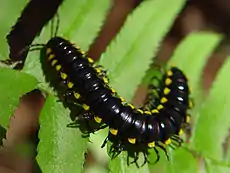Segmentation
Segmentation in biology means the division of some animal and plant bodies into a series of repeat sections or parts. It is common in some of the most successful groups of animals, such as arthropods, vertebrates and annelid worms.


Segmentation of the body allows different regions of the body to develop for different uses.
Genes regulating development
We now know a good deal about how the development of segmented animals is controlled. In a series of experiments with the fruit-fly Drosophila, E.B. Lewis was able to identify a complex of genes whose proteins bind to the regulatory regions of target genes. The latter then activate or repress cell processes which direct the final development of the organism.[1][2]
Furthermore, the sequence of these control genes show co-linearity: the order of the loci in the chromosome parallels the order in which the loci are expressed along the anterior-posterior axis of the body. Not only that, but this cluster of master control genes programs the development of all higher organisms.[3][4]
Each of the genes contains a homeobox, a remarkably conserved DNA sequence. This suggests the complex itself arose by gene duplication.[5][6][7]
In his Nobel lecture, Lewis said "Ultimately, comparisons of the [control complexes] throughout the animal kingdom should provide a picture of how the organisms, as well as the [control genes] have evolved".[8]
References
- Lewis E.B. 1995. The bithorax complex: the first fifty years. Nobel Prize lecture. Repr. in Ringertz N. (ed) 1997. Nobel lectures, Physiology or Medicine. World Scientific, Singapore.
- Lawrence P. 1992. The making of a fly. Blackwell, Oxford.
- Duncan I. 1987. The bithorax complex. Ann. Rev. Genetics 21, 285–319.
- Lewis E.B. 1992. Clusters of master control genes regulate the development of higher organisms. J. Am. Medical Assoc. 267, 1524–1531.
- McGinnis W. et al. 1984. A conserved DNA sequence in homeotic genes of the Drosophila antennipedia and bithorax complexes. Nature 308, 428–433.
- Scott M.P. and Weiner A.J. 1984. Structural relationships among genes that control developmental sequence homology between the antennipedia, ultrabithorax and fushi tarazu loci of Drosophila. PNAS USA 81, 4115.
- Gehring W. 1999. Master control systems in development and evolution: the homeobox story. Yale.
- Duncan I. and G. Montgomery 2002. E.B. Lewis and the bithorax complex. Part I. Genetics 160: 1265–1272. PMC free article: Duncan I. and G. Montgomery 2002. E.B. Lewis and the bithorax complex. Part II. Genetics 161: 1–10. PMC free article